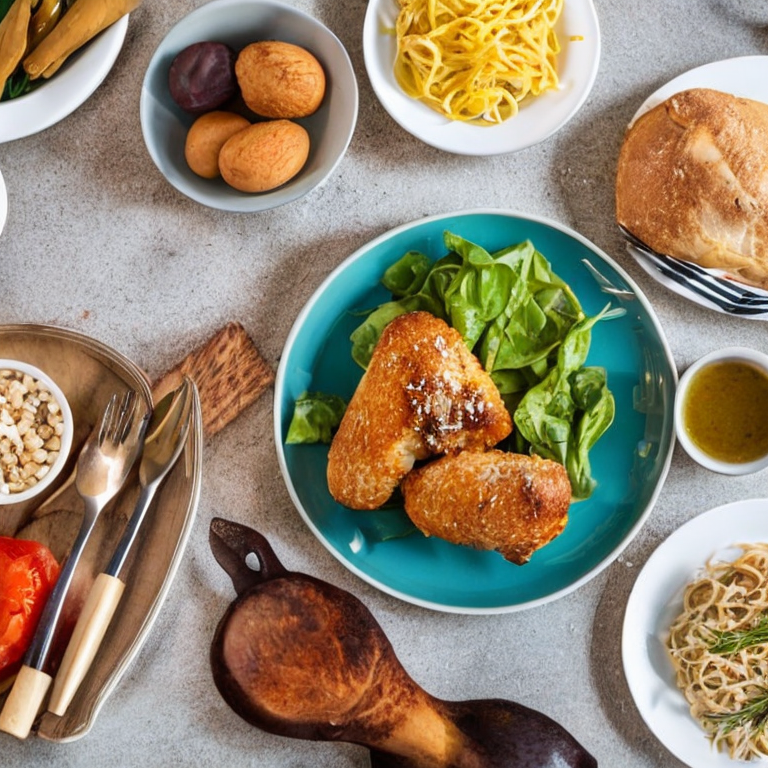Going Gluten-Free: A Review of the Best Recipes, Ingredients, and Techniques
Going gluten-free has become a popular dietary trend in recent years, with many people choosing to eliminate gluten from their diets for a variety of reasons. Whether you have celiac disease or gluten intolerance, or simply prefer to avoid gluten for health or lifestyle reasons, there are plenty of delicious gluten-free recipes, ingredients, and techniques that you can use to create satisfying meals and snacks. In this article, we’ll explore the best practices for going gluten-free, from understanding what gluten is and which ingredients to avoid, to stocking your pantry with gluten-free staples, cooking with gluten-free flours, and adapting your favorite recipes to be gluten-free.
Understanding Gluten and Gluten-Free Diets
Gluten is a protein found in wheat, barley, and rye, which can cause digestive problems for some people. For those with celiac disease, consuming gluten can trigger a range of symptoms, including abdominal pain, diarrhea, and weight loss. Gluten intolerance, which is less severe than celiac disease, can also cause bloating, gas, and other uncomfortable symptoms. To avoid gluten, it’s important to read food labels carefully and choose foods that are labeled gluten-free or are made with gluten-free ingredients. Some common sources of hidden gluten include soy sauce, beer, and processed foods like packaged snacks and frozen meals.
Stocking Your Pantry with Gluten-Free Staples
When going gluten-free, it’s important to have a well-stocked pantry of gluten-free staples that you can use to make meals and snacks. Some essential gluten-free pantry items include gluten-free flours (such as almond flour, coconut flour, and rice flour), gluten-free pasta and grains (such as quinoa and brown rice), gluten-free bread and crackers, and gluten-free snacks (such as nuts, seeds, and dried fruit). You may also want to invest in gluten-free baking ingredients, such as xanthan gum and baking powder, which can help you achieve the texture and flavor of traditional baked goods without gluten.
Cooking Essentials: The Top Gluten-Free Flours
Cooking with gluten-free flours can be challenging, since gluten gives wheat flour its elasticity and helps baked goods rise. However, there are many gluten-free flours that can be used as substitutes for wheat flour, depending on the recipe. Some of the top gluten-free flours include almond flour (which is high in protein and healthy fats), coconut flour (which is high in fiber and low in carbs), and rice flour (which is versatile and easy to find). Other gluten-free flours to try include oat flour, sorghum flour, and chickpea flour. It’s important to note that gluten-free flours may require different ratios of liquid and other ingredients than wheat flour, so be sure to follow recipes carefully and experiment to find the right combination of ingredients.
From Breakfast to Dessert: Gluten-Free Recipe Roundup
One of the most exciting aspects of going gluten-free is discovering new recipes and flavors that you may not have tried before. From breakfast dishes like gluten-free pancakes and waffles to savory meals like gluten-free pizza and pasta, there are plenty of options for creating tasty gluten-free meals and snacks. For dessert, gluten-free baking can be a fun and rewarding way to experiment with new flavors and ingredients. Some popular gluten-free dessert recipes include chocolate chip cookies made with almond flour, banana bread made with coconut flour, and apple crumble made with gluten-free oats.
Gluten-Free Baking: Tips and Tricks for Success
Baking gluten-free can be challenging, since gluten plays such an important role in the texture of baked goods. However, there are many tips and tricks to help you achieve great results when baking gluten-free. Some key strategies include using gluten-free flours that are appropriate for the recipe, using xanthan gum or other binders to help the batter stick together, and experimenting with different ratios of liquid and dry ingredients. It’s also important to be patient and persistent, since it may take some trial and error to find the right combination of ingredients and techniques.
Gluten-Free Comfort Foods: Satisfy Your Cravings
If you’re a fan of comfort foods like pasta, pizza, and fried chicken, you may be worried about missing out on these classic dishes when going gluten-free. However, there are many ways to create tasty gluten-free versions of your favorite comfort foods. Some tips include using gluten-free pasta made from rice or corn, making gluten-free pizza dough using a combination of gluten-free flours, and coating chicken or fish in gluten-free breadcrumbs made from almond meal or cornflakes. With a bit of creativity and experimentation, you can enjoy all the flavors and textures of your favorite comfort foods while staying gluten-free.
Healthy Eating Made Easy: Gluten-Free Meal Planning
Meal planning can be a helpful tool for staying on track with a gluten-free diet and ensuring that you have plenty of nutritious, satisfying meals and snacks to choose from. When planning meals, focus on incorporating a variety of gluten-free whole foods, such as fruits, vegetables, lean proteins, and healthy fats. Some easy gluten-free meal ideas include roasted vegetables with quinoa, gluten-free pasta with tomato sauce and grilled chicken, and gluten-free wraps filled with hummus and veggies. Be sure to also plan for healthy snacks, such as fresh fruit, nuts, and gluten-free crackers.
How to Adapt Your Favorite Recipes to Be Gluten-Free
If you have a favorite recipe that contains gluten, don’t despair! There are many ways to adapt traditional recipes to be gluten-free. Some simple substitutions include using gluten-free flour blends in place of wheat flour, using quinoa or rice in place of couscous or bulgur, and using gluten-free breadcrumbs made from gluten-free crackers or cornflakes in place of regular breadcrumbs. With a bit of experimentation and creativity, you can create delicious gluten-free versions of your favorite dishes.
Dining Out Gluten-Free: Navigating Menus and Restaurants
Dining out can be stressful when you have to avoid gluten, but with a bit of preparation, it’s possible to find tasty, gluten-free options at restaurants. Many restaurants now offer gluten-free menus or can provide information about which dishes are safe for those with celiac disease or gluten intolerance. Be sure to ask questions about ingredients and preparation methods, and consider bringing your own gluten-free sauces or condiments if you’re unsure about the restaurant’s offerings.
Gluten-Free Snacks and Party Foods: Entertaining Made Easy
Whether you’re hosting a party or simply need some quick and easy snacks, there are plenty of gluten-free options to choose from. Some simple gluten-free snacks include fresh fruit, nuts, gluten-free crackers and hummus, and popcorn. For party foods, consider making gluten-free versions of your favorite dips and appetizers, such as guacamole, salsa, and deviled eggs. You can also create a gluten-free charcuterie board with gluten-free crackers, cheese, and meats.
The Future of Gluten-Free Eating: New Products and Trends
As the demand for gluten-free products grows, so do the options available to those who follow a gluten-free diet. In recent years, there has been a surge in gluten-free alternatives to traditional foods, such as gluten-free pizza crust and bread. There has also been a trend towards using alternative flours and grains, such as quinoa and almond flour, in place of traditional wheat flour. With new products and ingredients hitting the market all the time, the future of gluten-free eating looks bright.
In conclusion
Going gluten-free can be a challenging but rewarding experience. With a bit of preparation and experimentation, you can create delicious, satisfying meals and snacks that are free from gluten. By understanding the basics of gluten-free cooking and stocking your pantry with the right ingredients, you can enjoy all the flavors and textures of your favorite dishes while staying on track with your dietary goals. Whether you’re a seasoned gluten-free chef or just starting out, there are plenty of resources and recipes available to help you succeed.







